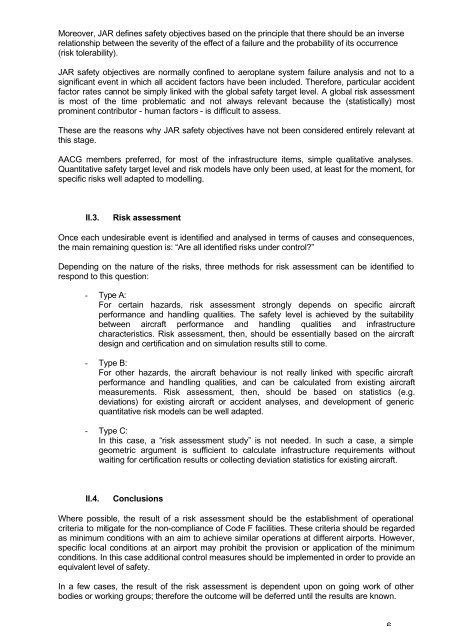Common Agreement Document of the A380 Airport Compatibility ...
Common Agreement Document of the A380 Airport Compatibility ...
Common Agreement Document of the A380 Airport Compatibility ...
You also want an ePaper? Increase the reach of your titles
YUMPU automatically turns print PDFs into web optimized ePapers that Google loves.
Moreover, JAR defines safety objectives based on <strong>the</strong> principle that <strong>the</strong>re should be an inverse<br />
relationship between <strong>the</strong> severity <strong>of</strong> <strong>the</strong> effect <strong>of</strong> a failure and <strong>the</strong> probability <strong>of</strong> its occurrence<br />
(risk tolerability).<br />
JAR safety objectives are normally confined to aeroplane system failure analysis and not to a<br />
significant event in which all accident factors have been included. Therefore, particular accident<br />
factor rates cannot be simply linked with <strong>the</strong> global safety target level. A global risk assessment<br />
is most <strong>of</strong> <strong>the</strong> time problematic and not always relevant because <strong>the</strong> (statistically) most<br />
prominent contributor - human factors - is difficult to assess.<br />
These are <strong>the</strong> reasons why JAR safety objectives have not been considered entirely relevant at<br />
this stage.<br />
AACG members preferred, for most <strong>of</strong> <strong>the</strong> infrastructure items, simple qualitative analyses.<br />
Quantitative safety target level and risk models have only been used, at least for <strong>the</strong> moment, for<br />
specific risks well adapted to modelling.<br />
II.3. Risk assessment<br />
Once each undesirable event is identified and analysed in terms <strong>of</strong> causes and consequences,<br />
<strong>the</strong> main remaining question is: “Are all identified risks under control?”<br />
Depending on <strong>the</strong> nature <strong>of</strong> <strong>the</strong> risks, three methods for risk assessment can be identified to<br />
respond to this question:<br />
- Type A:<br />
For certain hazards, risk assessment strongly depends on specific aircraft<br />
performance and handling qualities. The safety level is achieved by <strong>the</strong> suitability<br />
between aircraft performance and handling qualities and infrastructure<br />
characteristics. Risk assessment, <strong>the</strong>n, should be essentially based on <strong>the</strong> aircraft<br />
design and certification and on simulation results still to come.<br />
- Type B:<br />
For o<strong>the</strong>r hazards, <strong>the</strong> aircraft behaviour is not really linked with specific aircraft<br />
performance and handling qualities, and can be calculated from existing aircraft<br />
measurements. Risk assessment, <strong>the</strong>n, should be based on statistics (e.g.<br />
deviations) for existing aircraft or accident analyses, and development <strong>of</strong> generic<br />
quantitative risk models can be well adapted.<br />
- Type C:<br />
In this case, a “risk assessment study” is not needed. In such a case, a simple<br />
geometric argument is sufficient to calculate infrastructure requirements without<br />
waiting for certification results or collecting deviation statistics for existing aircraft.<br />
II.4. Conclusions<br />
Where possible, <strong>the</strong> result <strong>of</strong> a risk assessment should be <strong>the</strong> establishment <strong>of</strong> operational<br />
criteria to mitigate for <strong>the</strong> non-compliance <strong>of</strong> Code F facilities. These criteria should be regarded<br />
as minimum conditions with an aim to achieve similar operations at different airports. However,<br />
specific local conditions at an airport may prohibit <strong>the</strong> provision or application <strong>of</strong> <strong>the</strong> minimum<br />
conditions. In this case additional control measures should be implemented in order to provide an<br />
equivalent level <strong>of</strong> safety.<br />
In a few cases, <strong>the</strong> result <strong>of</strong> <strong>the</strong> risk assessment is dependent upon on going work <strong>of</strong> o<strong>the</strong>r<br />
bodies or working groups; <strong>the</strong>refore <strong>the</strong> outcome will be deferred until <strong>the</strong> results are known.<br />
6

















